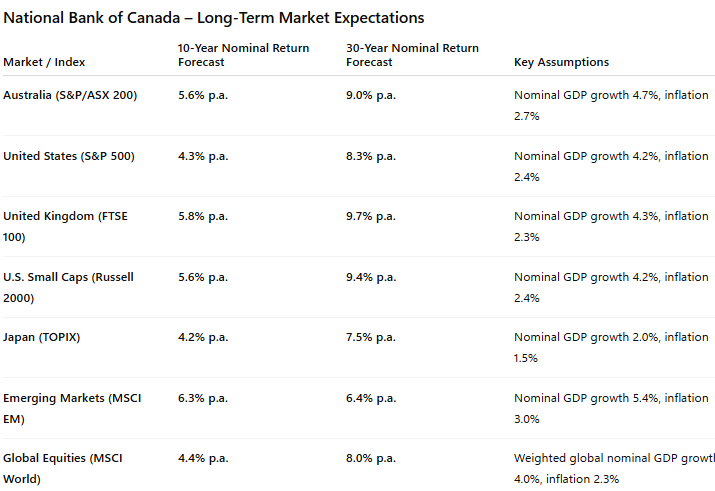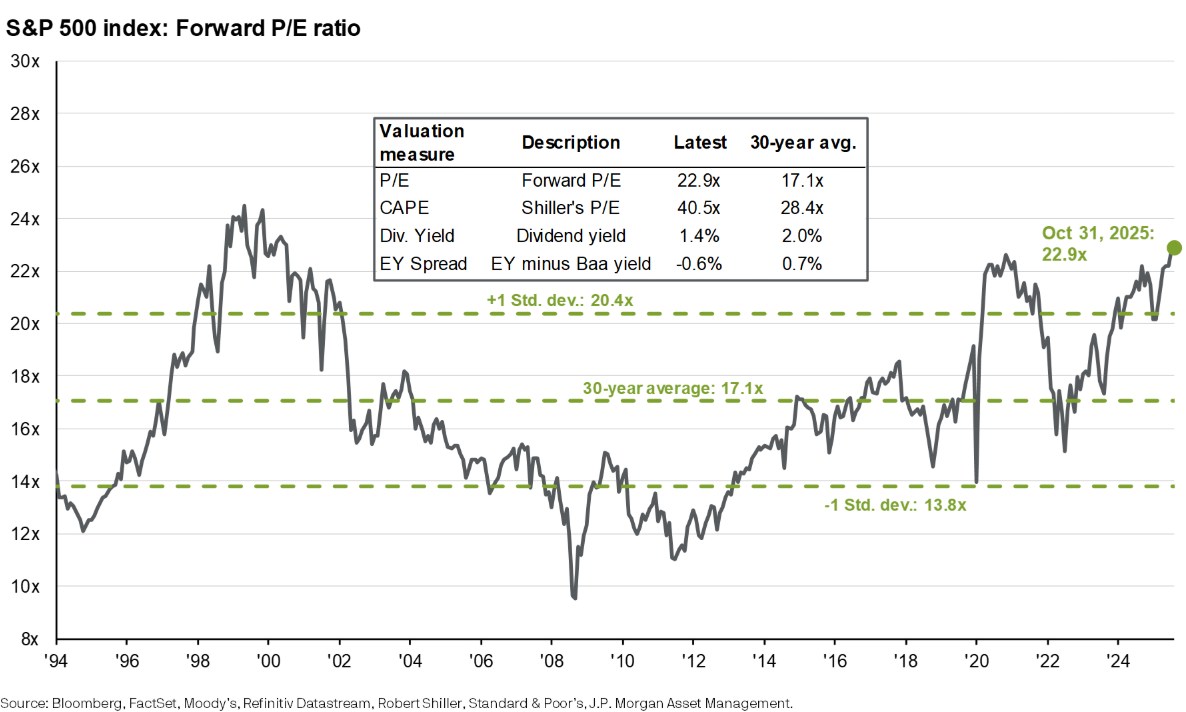Australian equities set to outshine the U.S. in the decade ahead
A major Canadian bank has just tipped Australian equities as among the asset classes with the best 10- and 30-year return prospects.
Australia outshining the U.S. after nearly two decades of lagging? Say it isn’t so. Yet National Bank of Canada believes the S&P/ASX 200 will deliver annual total returns of 5.6% over the next 10 years, rising to 9% over 30 years - among the highest projections of any developed market.
This view that the era of U.S. exceptionalism is fading and the next several decades could belong to Australia, emerging markets, and other value-linked indices is, at its core, a valuation story.
And it’s not a fringe view. It’s shared by a group of global asset allocators collectively managing more than $27 trillion, including Vanguard, State Street, and MFS.
Notably, these same forecasters also see better days ahead for fixed income, with government bonds expected to return above 3% and corporate bonds north of 4% - a meaningful recovery for investors starved of yield for much of the past decade.

Valuations and fundamentals: the great rebalancing
While each firm takes a different approach to their long-term return assumptions, they all come to the same conclusion: returns are (or should) ultimately reflect fundamentals.
State Street argues that markets are anchored to slow-moving economic forces rather than short-term noise:
“We believe that over the long term, prices are anchored to some sort of a slow-moving, fundamentals-anchored process, while in the short term, these same prices cycle quasi-randomly around such anchors,” State Street says.
“Thus, the returns on most financial assets can be effectively separated into a long-term component linked to economic fundamentals and a transient part linked to ‘excess volatility’ or other noise.”
In other words, the surge that drove U.S. assets higher for much of the past decade is giving way to a more balanced environment where valuation, productivity, and income yield again determine long-run outcomes.
Australia: steady hands, solid dividends
Vanguard’s report shows the Australian economy regaining momentum after two sluggish years, driven by rate cuts, fiscal support, and a pickup in consumer spending.
The firm expects 2% gross domestic product (GDP) growth in 2025, underpinned by stronger household spending and easing inflation, though it cautions that weak productivity growth continues to restrict the effect of monetary policy easing.
From an investment perspective, that backdrop supports Vanguard’s 4.8–6.8% 10-year return forecast for Australian equities, one of the highest among developed markets.
The Canadians are broadly aligned with Vanguard’s economic outlook, which effectively makes Australia the envy of the developed world - with real GDP growth projected to trail only emerging markets, at around 3.6%.
The S&P/ASX 200 remains the highest-yielding market in the developed world, offering an annual dividend yield of 3.12% plus an average franking credit of 0.95% as at the end of September. By comparison, the S&P 500 yields just 1.16%.
USA: Priced for perfection?
The contrast with the U.S. is stark.
MFS forecasts just 1.6% annual returns for U.S. equities, highlighting that valuations are stretched and margins unsustainably high.
“U.S. equities remain near the upper end of their historical valuation range,” MFS notes.“In contrast, international and emerging markets equities are projected to deliver higher returns at 6.4% and 8.2%, respectively. This disparity is driven by cheaper valuations and expectations for profit margin expansion outside the U.S.”
The chart below from J.P. Morgan Asset Management shows the S&P 500 trading at 22.9 times earnings, compared with its 30-year average of 17.1 times earnings. Interestingly, Australian equities are slightly more expensive at 23.6 times, though the forecasters argue local valuations are supported by stronger fundamentals.

National Bank expects 4.3% annualised returns over 10 years and 8.3% over 30 years - respectable, but well below the market’s historical average.
The common thread: the U.S. isn’t doomed, but it’s fully priced. Future gains will likely come from earnings and dividends rather than multiple expansion.
Emerging markets: back in the spotlight
After years in the shadows, emerging markets are back on the radar.
National Bank expects 6.3% annual returns, State Street 7.4%, and MFS 8.2%.
Each point to favourable demographics, rising productivity, and lower starting valuations as tailwinds.
MFS attributes the higher return outlook for markets outside the U.S. to lower valuations and the potential for profit margin recovery. It notes that global profit margins, now around 12% versus a 10-year average of 10.3%, are largely inflated by U.S. companies.
"As a result, future returns are expected to be driven primarily by sales growth and dividends rather than further margin expansion or valuation increases," MFS says.
Fixed income: attractive starting yields, lingering inflation risks
In fixed income markets, starting yields are now near or above long-term total returns, presenting some of the most attractive entry points for bond investors in over a decade - particularly in credit.
Across the major forecasts, 10-year nominal return expectations range between 3.5% and 5.0%.
- Vanguard expects 3.6–4.6% for Australian bonds and 4.1–5.1% for global bonds.
- State Street forecasts 4% for Australian government bonds and 4.3% for corporates.
- MFS projects around 4.8% for global fixed income.
- National Bank of Canada expects 4.0–5.1% across North American government and corporate debt.
That means bonds - whose role in 60/40 portfolios was called into question after the experience of 2022 - are once again capable of producing real, positive returns for balanced portfolios.
Still, inflation remains a key risk across all outlooks, particularly given the stickiness of U.S. inflation and the potential for renewed price pressures from tariffs, supply chain disruptions, or other unforeseen events.
Surprising contenders
As a final interesting observation for Australian investors and advised portfolios, several of the long-term outlooks are particularly favourable toward British equities and U.S. small caps — two areas that have lagged in recent years but may be poised for a comeback.
According to the National Bank of Canada, the FTSE 100 is forecast to return 5.8% per year over 10 years and 9.7% per year over 30 years, while the Russell 2000 (U.S. small caps) is expected to deliver 5.6% per year over 10 years and 9.4% per year over 30 years.
MFS projects a similar return profile for U.S. equities overall, but expects U.S. small caps to generate 4.3% annualised returns, compared with just 1.3% for large caps — a notable divergence that underscores the value gap building beneath the surface.
“Opportunities within equity markets are particularly pronounced in mid-cap and smaller capitalization stocks. Mid-caps, which are trading at around two standard deviations cheaper relative to large caps, present an attractive entry point for portfolios overweight in large-cap stocks,” MFS says.
How to play it through ETFs?
For investors looking to position around the opportunities highlighted in these long-term forecasts, several ASX-listed ETFs provide straightforward access to the key themes:
Vanguard Australian Shares Index ETF (ASX: VAS) – broad exposure to large and mid-cap Australian companies across the S&P/ASX 300.
iShares MSCI Emerging Markets ETF (ASX: IEM) – diversified access to fast-growing economies such as China, India, and Brazil.
Betashares FTSE 100 ETF (ASX: F100) – exposure to the U.K.’s largest listed companies including AstraZeneca, HSBC, and Shell.
iShares Russell 2000 ETF (ASX: IRU) – a window into 2,000 U.S. small-cap stocks spanning industrials, healthcare, and technology.
iShares Core Composite Bond ETF (ASX: IAF) – exposure to Australian government, semi-government, and corporate debt.
PIMCO Global Credit Active ETF (ASX: PCRD) – an actively managed portfolio of global investment-grade and high-yield corporate bonds.

3 topics
